|
If you are like most
people, you will be bringing your mobile phone
with you on your vacation. You may be using
it specifically for your travel photos as
today's smart phones take wonderful clear high
resolutions photos. Smartphones can allow photos to be instantly posted to your
social media websites if you want to share them with others.
We bring our smart phone
with us on our travels for accessing our trip
details using the
Mobile Trip Profile. Of course
we also use it to stay in touch with friend and
family, and for navigation
if required. When
we travel, we always
bring a high quality compact digital camera.
If you want to post
photos to the internet or email them, many cameras offer
wireless connectivity allowing you to take
photos and transfer them to your phone. Excuse the
pun, but we are not 'focusing' on SLR type
cameras here due to their size, weight and cost.
Our focus is on Traveling Lightly so carrying a compact style camera
is the way to go.
With today's technology and cameras, you
probably won't be able to tell the difference
between photos taken with a compact camera
compared to a
larger SLR camera; even when enlarging photos up
to 11x14 inches. To make the
most of your photography, it's extremely
important to know some basic camera
functionality. View our
Photography Basics page for some tips on
camera functionality. Our Tripod
page will give you an overview on taking self
photos, night photos and zooming.
Of course there are many
different cameras available today with many
different features and prices.
We have listed some features below to consider when purchasing a
camera and accessories for your travels.
We
are mentioning the Lumix line of cameras
based on our own personal experience and satisfaction
with them.
|
|
|
Panasonic Lumix ZS100 Camera |
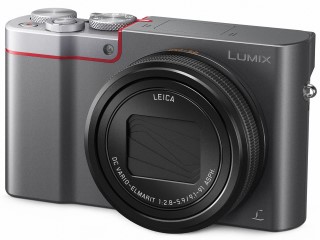
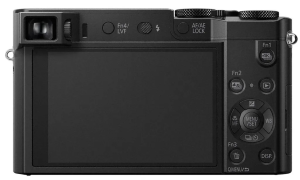
 |
PANASONIC LUMIX
ZS100 4K Point and Shoot Camera, 10X LEICA DC Vario-ELMARIT F2.8-5.9 Lens
with Hybrid O.I.S., 20.1 Megapixels, 1
Inch High Sensitivity Sensor, 3 Inch
LCD, DMC-ZS100S (USA SILVER)
This is now our camera of choice and
we have been very pleased with it.
This camera has the same 10x Zoom as our old
TZ3k shown above. We have find that
having a
10x zoom is completely sufficient for
our photography. Zooming past the
10x mark will often require a tripod to
hold the camera steady and with smaller
sensor cameras, zooming above 10x-15x
can limit the amount of light captured
causing photos to lack quality compared
shorter zoom lengths.
We are now seeing more compact
digital cameras having a larger 1 inch
sensor allowing more light to be
captured, increasing the photo quality.
These cameras are pricier but if you can
afford it, you may find your photos to
much better than the older cameras
having smaller sensors.
- Larger 1 inch sensor
- 20 Megapixels
- 10x (25-250mm) LEICA DC Lens optical
zoom performance with a wide F/2.8-5.9
aperture for impressive background
defocus effects
- 4K Ultra HD video recording plus
exclusive LUMIX 4K PHOTO and 4K Post
Focus photo capture features
- Eye-level Electronic Viewfinder (EVF)
- Touch-enabled LCD for a wider
viewing experience
- Lens-mounted control ring brings DSLR-like
exposure control to a compact
point-and-shoot camera body
At the time of this writing,
Panasonic has just released their new
Lumix ZS200. Reviews are
still coming in and we have not
researched the camera. The price
point is several hundred dollars above
the ZS100. |
|
|
|
|
|
Panasonic Lumix ZS70 Camera |
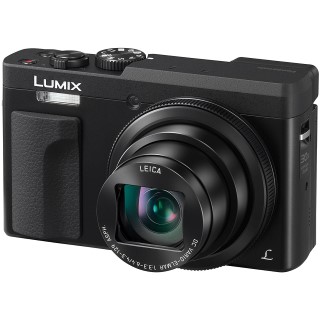 |
Also available are
the Panasonic Lumix ZS60 and
ZS70. These are slightly older
models than the newer ZS100 but they are
much more affordable.
The ZS70 is a 20.3 Megapixel
camera with a 1/2.3 in. sensor and 30x
Optical Zoom. An earlier version
still available is the ZS60 having
a lower price point. The features
of both models are very similar although
he ZS70 has introduced a few new
features such as a flip up view screen
and others.
We found reviews of both the ZS60 and
ZS70 stating that image quality suffered
in low light conditions. We actually purchased
a ZS60 to test it out and found
this to be true. After several
tests, we decided to return the camera
and go for the
ZS100.
Our advice is to
do your own research. Spend some
time reading, researching and if
possible test some different cameras to
find the one that's right for you.
|
|
|
|
|
|
Panasonic
Lumix DMC-TZ3K 7.2MP
(Older Model) |
For reference, this is our old Lumix model we
used for approximately 10 years of
travel.
It has been a great camera and we have
been extremely satisfied with the photo
quality and it's features. In
fact, it still takes great photos and
even wonderful night photos after
all these years. We do not
actually recommend purchasing this
camera if you find one due to it's age.
Newer models are more feature
packed and would undoubtedly take better
photos. We have seen used cameras advertised for
around $60.
-
7.2-megapixel CCD captures enough
detail for photo-quality 15 x
20-inch prints
- 10x
image-stabilized optical zoom;
3.0-inch LCD display
- Intelligent
ISO Control (I.I.C.) reduces image
blur from subject movement and low
light
- Records
full-size movies in wide-aspect VGA
(848 x 480) at 30 frames per second
- Stores
images on SD/SDHC/MMC memory cards
The camera has a
28mm lens allowing you to take wide
angle photos when not zoomed. This
is approaching the wide angle limit
before falling into the distorted fish
eye range. |
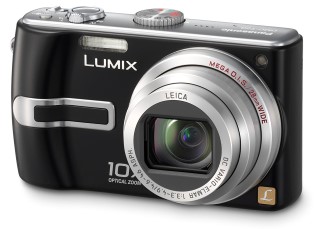 |
|
|
|
|
|
Important Camera Features |
|
Timer: |
When taking self photos
using your tripod, you must know how to
work your camera's timer. Most cameras have easy
access functions allowing
you to set the shutter timers in two
different modes. The length of
time may vary by camera, but in general
they are something like 4 and 10 second
delays.
The short 4
second timer can be used when taking extended zoom
and night photos using your Tripod where
you need the camera to be held
completely still to avoid blurriness in
your photos. This short timer allows you to
take photos quickly without having to
hit the shutter yourself and jar the
camera.
The longer 10 second timer allows you
time to click the shutter and get into
the photo before the shutter snaps. |
|
Exposure
Setting: |
Many cameras have a
dedicated button for the Exposure
Setting. This setting allows you
to control how long the shutter stays
open, usually having values of -2 to +2.
A negative number means the shutter will
stay open a shorter amount of time
letting in less light and a larger
number means the shutter will stay open
a longer amount of time letting in more
light. When taking night photos
for example, you will want
to set the exposure time so that the
shutter stays open longer to capture
more light. Some cameras allow
you to save your settings under a night
time icon so that switching to the
setting will maintain your exposure
settings for shooting in low light. |
|
Wide Angle Lens: |
As you tour around, you will find that many places are cramped with other
buildings blocking how far you may move
away from your photo subject. As
you move farther away, you may
eventually not be able to capture your
subject as it will become blocked by
other buildings. Having a camera
with a wide angle lens will give you
more opportunity to capture the photo
the way you want it.
A camera with a 28mm lens allows you to take wide angle
photos when not zoomed. The 28mm
setting is
approaching the wide angle limit before
falling into the distorted fish eye
range.
If you have ever
been to Ulm Germany and tried to
photograph Ulm Minster, you will know
what we are talking about. Ulm Minster
is the tallest church in the world, and
the 4th tallest structure built before
the 20th century, with a steeple
measuring 161.5 meters (530 ft).
Without a wide angle lens, it would be
virtually impossible to capture the
entire cathedral. |
|
Optical Zoom: |
The optical zoom is one of the most
important aspects of your camera as it
allows you to zoom closer to objects
your are photographing. The
optical zoom is a true zoom of the
objects you are photographing without
the distortion that occurs with a
digital zoom. Keep in mind that
the more you zoom, the more the camera must be
held steady to avoid movement and blurry photos.
This is where a
Tripod
becomes invaluable
to stabilize the camera movement. |
|
Digital Zoom: |
Most cameras have a
digital zoom that will come into play
once you have reached the limit of the
optical zoom. The digital zoom measurement
should probably be the least of your
your concerns as the quality of your
photos will decrease when your camera
changes from optical to digital as the
camera uses it's computer to digitally
enhance the optical view by cropping and
removing pixels from the image making it
appear magnified. |
|
Megapixels & Sensor: |
Don't be fooled, the more pixels you
have does not mean the sharper the
image. More important is the
camera's
sensor size. Compact
digital cameras seem to have an internal sensor
around 1/2 inch which is considerably
smaller compared to more expensive SLR
cameras. We are however beginning
to see compact digital cameras with a
sensor of 1 inch such as the Panasonic Lumix ZS100, but the
optical zoom lenses are limited and the price is more than
double that of the ZS50. |
|
Photo Quickness: |
Photo Quickness is the length of time it
takes to take a photo once you have
turned your camera on or the time you
have to wait in-between shots.
This may seem trivial, but you don't
want to miss out on a photo
opportunities waiting for your camera to
respond. We suggest trying cameras
at the store to get a feel for the
length of time you wait between photos. |
|
Preset Settings: |
Besides the normal settings, you may want
preset settings for night photos, high
speed photos and others. Most cameras come
with several different pre-sets such as
night, action, portrait, clouds,
sunny, etc. |
|
Viewfinder: |
We are now seeing
more cameras having both an optical
viewfinder allowing you to look directly
at what you are photographing as well as
a digital display panel on the back.
Not having a viewfinder has not really
been as issue, but if you are
concerned with shooting in bright
sunlight where the back screen may be
hard to see, you may want to consider a
camera having both viewing options.
The other advantage of the viewfinder
would be to turn off the back display
panel and only use the viewfinder to
conserve the battery. |
|
Photo Directory
Reset: |
Most digital cameras
should have the ability reset the
current photo directory. This will
allow you to group your photos by
location or activity so that all related
photos are in the same directory.
 After you reset the photo directory for
photos at a new location, if possible,
take at least one photo of a sign or
some other information that will help
you identify where the photo was taken.
After you reset the photo directory for
photos at a new location, if possible,
take at least one photo of a sign or
some other information that will help
you identify where the photo was taken. |
|
|
|
Batteries & Charger |
|
Batteries: |
When we travel, we
always bring an extra battery or two. Even if your camera and battery
are rated for 300+ photos, it's quite
easy to take many more photos than that in a
day.
 Always start your day with fully charged
batteries.
Always start your day with fully charged
batteries.
 Always bring an extra battery or two as
backups with a portable charger.
Always bring an extra battery or two as
backups with a portable charger. |
|
Charger: |
Depending on your
camera, you may plug it directly into
the wall to charge the battery, or plug
a charger into the wall. Either
way, you will more than likely you will
need the correct
Electrical Plug Adaptor for foreign
electrical outlets.
 Batteries may charge faster using an
actual charger compared to plugging the camera
in directly. Having a
charger will also allow you to use the
camera while spare batteries are
charging.
Batteries may charge faster using an
actual charger compared to plugging the camera
in directly. Having a
charger will also allow you to use the
camera while spare batteries are
charging.
Most European
electrical outlets run 220V compared to
US 110V. Be sure to read the small
print on your camera,
charger or device you intend to plug in to be
sure it can handle 220V. Most
will, but double check to be sure.
You should find something like:
Input: 110V-240V 50/60Hz.
|
|
|
|
|
|
BM Premium 2-Pack of
DMW-BLG10 Batteries and Battery Charger |
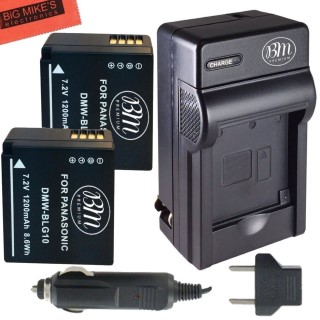 |
BM Premium 2-Pack of
DMW-BLG10 Batteries and Battery Charger
for Panasonic Lumix DC-ZS200, DC-ZS70,
DMC-GX80, DMC-GX85, DMC-ZS60, DMC-ZS100,
DMC-GF6, DMC-GX7K, DMC-LX100K Digital
Camera
- Two
DMWBLG10 Li-ion Batteries for Panasonic Lumix DC-ZS70, DC-ZS200, DMC-GX80,
DMC-GX85, DMC-ZS60, DMC-ZS100, DMC-GF6,
DMC-GX7K, DMC-LX100K Digital Cameras
- Battery Specifications - Energy
Storage Capacity: 1200mAh /Voltage: 7.2
volts, Chemistry: Li-ion
- No Memory Effect Lets You Recharge
Partially Drained Batteries Without
Reducing Performance
- Rapid AC/DC Battery Charger
- Folding plug on charger for
travel
- Cleaning Cloth
- Car plug adaptor
- European plug adaptor
|
|
|
|
|
|
Memory |
|
Extra Memory: |
You may or may not
need extra memory, but be sure you have enough to capture
all your photos on
your trip. If you find you
are running short on memory, it's
usually very easy to find a location to
purchase an additional card.
Remember that based on the camera
settings, photos can take different
amounts of memory on your card. For example, setting
your camera to take 5-6 Megapixel photos
may allow one memory card to hold
thousands of photos while setting it to
take 20 Megapixel photos may limit it
to several hundred. |
|
Case |
|
Carrying Case: |
Having the right
case and features is
important. When looking for a
case, select one with a fixed belt loop
attachment and separate storage
compartments for an extra battery and
memory card.
|
|
|
Fit: |
Find a case that is
padded and your camera fits snugly
inside. |
|
Wearable: |
Cases for compact
cameras are small, so
make sure they can be worn on your belt.
Wearing your case on your belt in front makes
it very secure and convenient to access the camera.
 Make sure the case has a belt loop and
not a clip making it much more secure.
Avoid a belt look with a Velcro closure
as fixed loops are much more secure.
Make sure the case has a belt loop and
not a clip making it much more secure.
Avoid a belt look with a Velcro closure
as fixed loops are much more secure.
Your case may
also have a place to attach a strap for
wearing it over your shoulder.
This is fine, but it is a less secure
method compared to that of a belt
loop. |
|
Closures: |
Make sure all
compartments are
zippered offering greater security.
Having a case with Velcro, magnet or
snap closure is less secure and will not keep
your camera as clean and safe. |
|
Compartments: |
The case should
have a separate compartment just large
enough to store an extra battery and
memory card. |
|
|
|
Case Logic
DCB313 Advanced Point & Shoot Camera
Case |
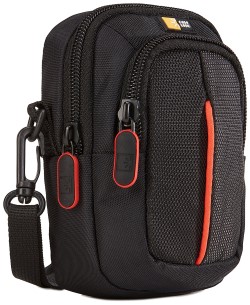 |
- Quality
materials and logical organization
ensure your equipment is stored
safely inside, yet instantly
accessible
- Zippered
front storage pocket holds up to 2
extra batteries with a separate
compartment for a memory card or
small accessory
- Comfortable
fit for these slightly larger
cameras
- Fits the
Lumix ZS60, ZS70 and ZS100 as well
as other comparably sized cameras
- Fully
adjustable detachable shoulder strap
- Fixed belt
loop
|
|
|
|
|
|
Final Thoughts |
|
Quality Cameras: |
There are many
different cameras available and our
experience is with the Lumix series.
Our advice is to purchase a high quality
camera which may cost several hundred
dollars more than some of the cheaper
models. Consider that you will
probably have the camera for years, so
spending slightly more may be well worth
the extra cost. As stated above,
we used our older Lumix for over 10
years before purchasing a new model. |
|
Snap Often: |
Today is not like the
olden days of expensive film and
developing costs. Remember, with digital cameras and large memory cards,
you can take multiple photos of the same
scene. So when photographing an
important subject, take several photos
helping to ensure you get the perfect
shot. After your trip when you
are reviewing your photos, you can
simply erase the ones you don't want.
This is why it's important to have
enough memory with you as you may take
thousands of photos on an extended trip. |
|
Be Respectful: |
Be respectful of locations not allowing
photos or flash-photos such as
religious sites and museums. It
can be tempting to sneak a photo but as
a good tourist, stay out of trouble and
don't risk having your camera confiscated.
Be respectful of photo restrictions. |
|
|
|
Security - Using your Camera on the
Train |
See our page
on
Don't Become a Target
for additional security information for
using your camera while on a train.
|
|
|
|